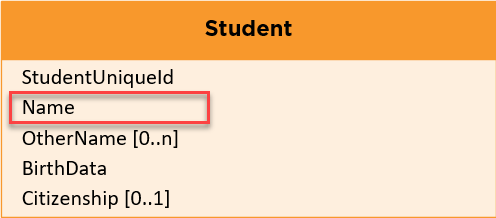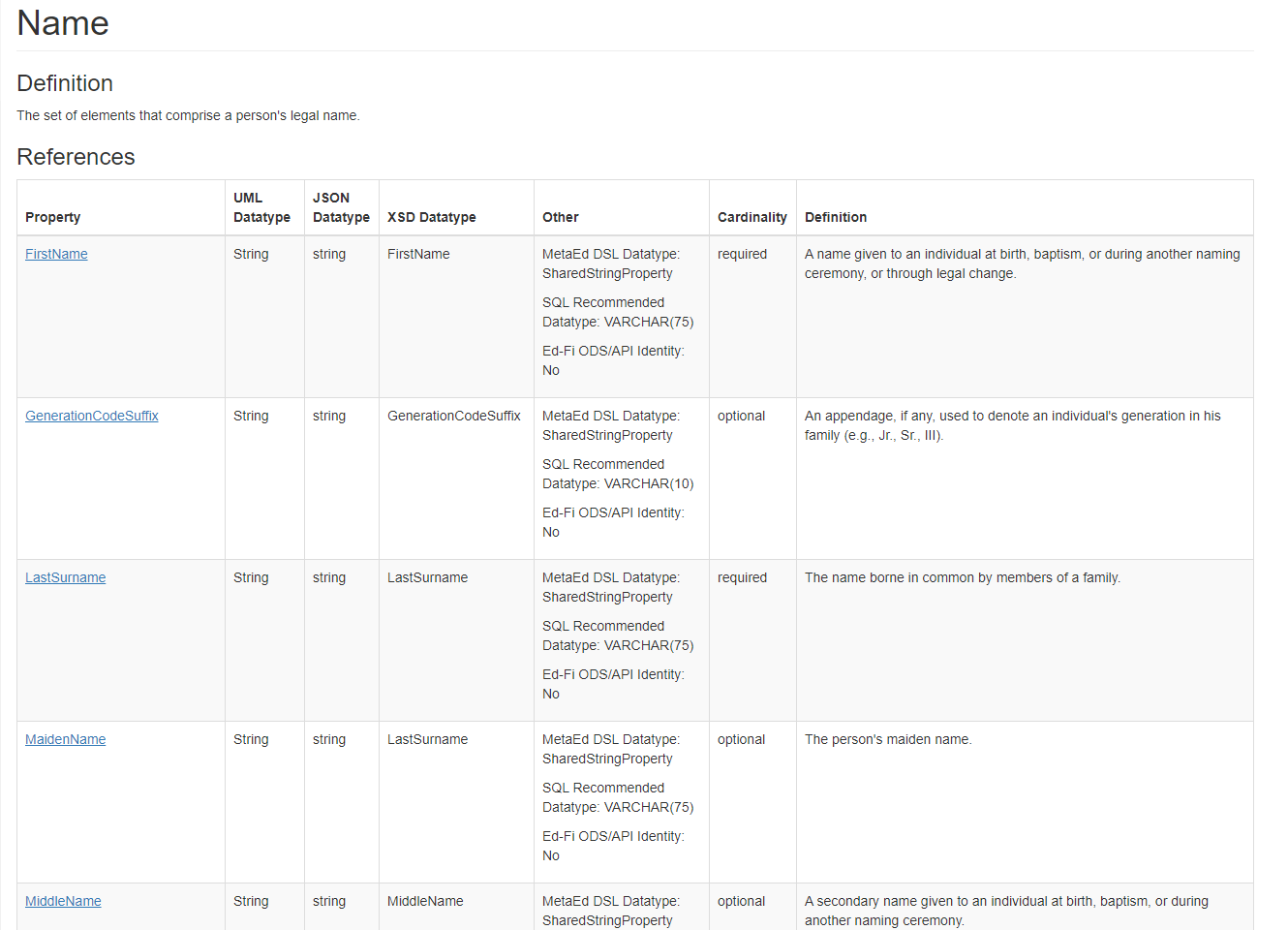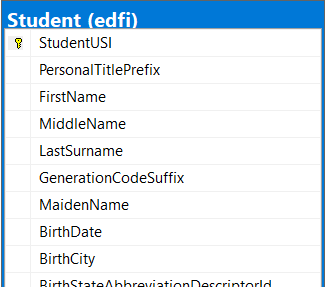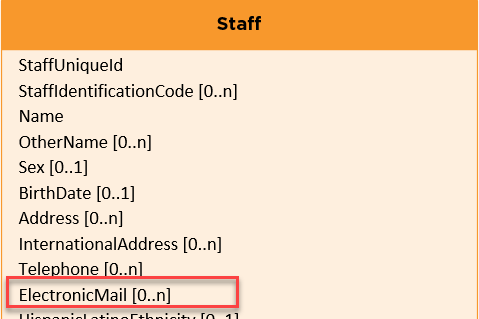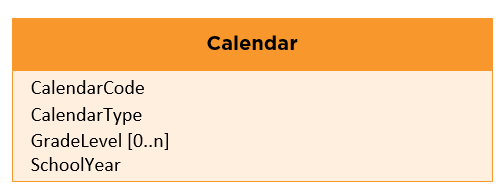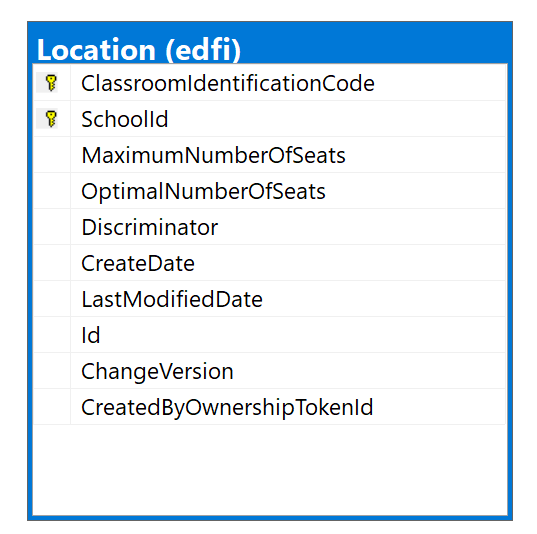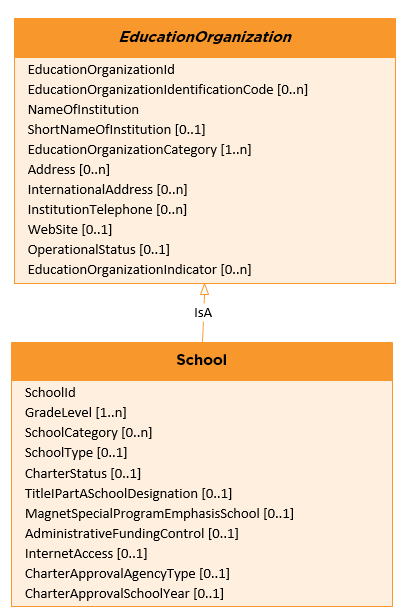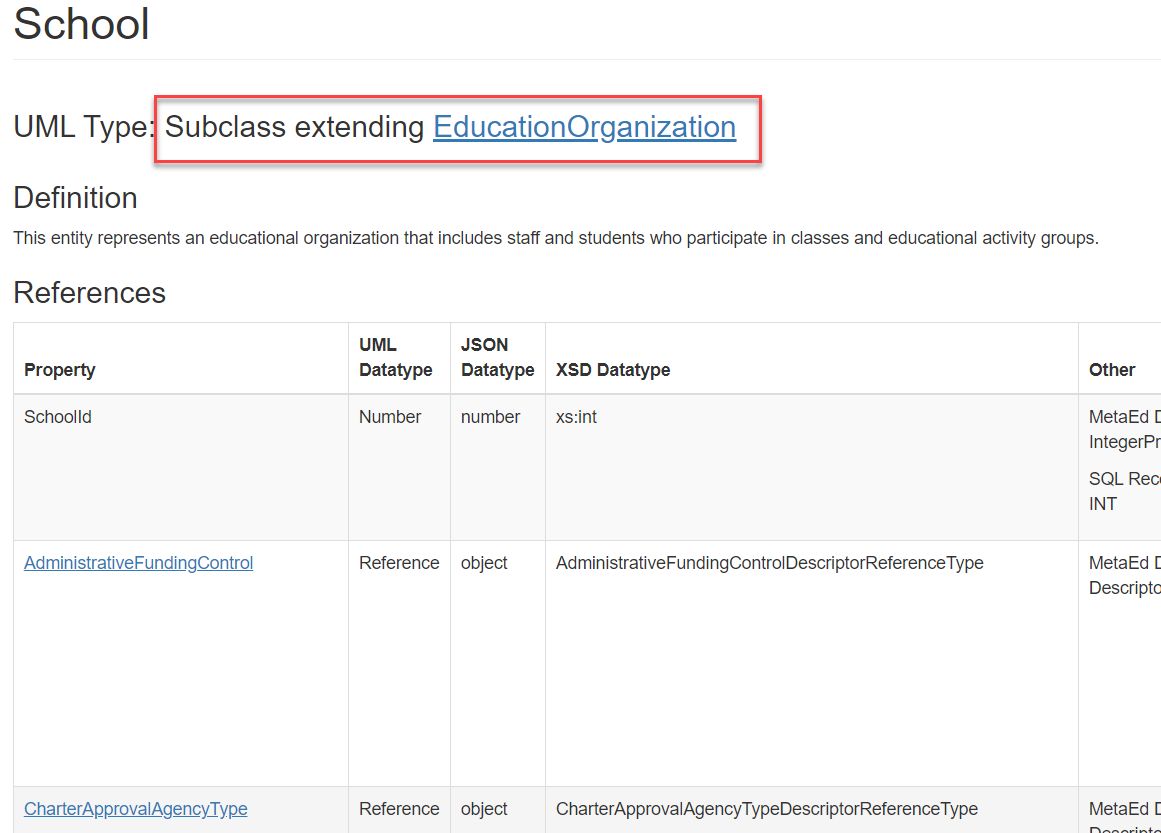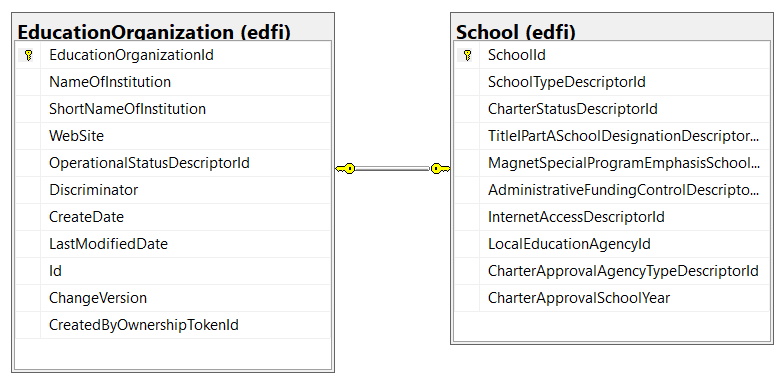Understanding UML, API and Database Expressions of the Ed-Fi Data Model
Table of Contents
Audience and Purpose
Technologists new to Ed-Fi's community can sometimes be confused as they navigate through multiple different expressions of the Ed-Fi Unifying Data Model. The core data model – represented in UML with an accompanying Data Handbook – looks a little different as it is expressed in JSON for for API and in relational database formats. This document helps technologists navigate key differences in these formats.
The document focuses how various features of the Ed-Fi UDM are materialized in JSON in the Ed-Fi REST API standards and in a relational format in the Ed-Fi Operational Data Store.
Ed-Fi XML formats are not covered, due to declining interest in and use of these by the community.
Background
The Ed-Fi Unifying Data Model (or UDM; below we will generally refer to this below as the "Ed-Fi data model") is a data model that is published in Unified Modeling Language (UML). It has an accompanying Data Handbook, which reproduces the schema in a narrative format, and provides full element definitions.
The UDM is a logical model, which means that it is expressed independent from any particular physical representation, such as a relational database, JSON, or XML schema.
The data model consists of entities, associations and attributes, as can be seen in this small section of the model.

The Ed-Fi Alliance also publishes data exchange standards that are derived from the Ed-Fi data model: vendors and others use these to interoperate - to send data in ways that conform to these standards. There are currently 2 data formats used in these standards:
- JSON - used by the Ed-Fi REST API standards
- XML - used by legacy Ed-Fi "bulk transfer" standards
These downstream standards are sometimes referred to as "bindings" for the data model.
Many are confused to learn that there is no "standard" relational database (or any other database) binding for the Ed-Fi data model.
Why is that? The main reason is that Ed-Fi data standards are primarily concerned with data in transit, and not data at rest (i.e. in storage).
There are many possible ways to store the same data in a database. A relational system may store it as a set of decomposed tables, while a document centric model may persist it as a JSON BLOB or text object. An object database may use a serialized binary format optimized for deserialization into a run-time environment.
Although there is no standard Ed-Fi database format, the Ed-Fi open source Operational Data Store (ODS) platform does contain a relational database version of the Ed-Fi data model. While this format is not a standard per se, it is clearly very important to the Ed-Fi community. For that reason we include this schema in our comparison.
Important Differences in Data Schemas
In the remaining sections of this document, we explore how various features of the Ed-Fi UDM are expressed in JSON (for the Ed-Fi REST API standards) and in the Ed-Fi ODS database schema.
In each case we start with the Ed-Fi data model, as it is the source artifact from which other representations derive.
Flattening Sub Classes
Summary: the Ed-Fi data model maintains a rich hierarchy of reusable sub- or contained classes, and these contained classes are sometimes "flattened" onto the entity in downstream data models.
A good example of flattening is the "Name" entity. If we look at Student in UDM, we see a"Name" entity. From the Data Handbook, we can see that Name is composed of several attributes: a FirstName, a LastSurname, etc.
| UML | Data Handbook |
|---|---|
|
click to expand |
But if we look in the API JSON model and in the ODS database, the elements of "name" have been flattened directly onto the entity. There is no independent "Name" entity - its attributes have been added directly to Student.
| API JSON | ODS Database |
|---|---|
{
"id": "string",
"studentUniqueId": "string",
"firstName": "string",
"generationCodeSuffix": "string",
"lastSurname": "string",
"maidenName": "string",
"middleName": "string",
[etc.]
}
|
|
We refer to this as a "contained class": Name is contained by Student. Some but not all contained classes behave this way, but be on the lookout for it if you find the models in various Ed-Fi expressions do not look similar.
Collections of Contained Classes
Summary: when an entity can have multiple instances of a contained class, the ODS Database will model this via multiple tables; the API model will resemble the UDM.
The flattening of Name is a simpler case because a student has only one name, so there is a 1:1 relationship between Student and Name. But what if the contained class is a collection?
A good example is ElectronicMail - just as Name is is composed of several attributes, ElectronicMail has several attributes: ElectronicMailAddress, ElectronicMailType, DoNotPublish indicator, etc.. But unlike Name, a Student or Staff can have multiple ElectronicMails. You can see this in the UML by the cardinality "0..n" (highlighted below).
| UML | Data Handbook |
|---|---|
|
Click to expand |
Collections of contained classes look different in the API and in the database.
In the API, this containment is represented as a hierarchy
| API JSON |
|---|
{
"id": "ff5e7ac270494bd091932e283e65b0e2",
"staffUniqueId": "207265",
"firstName": "Alvin",
"lastSurname": "Lee",
[etc.]
"electronicMails": [
{
"electronicMailAddress": "AlvinLee@edfi.org",
"electronicMailTypeDescriptor": "uri://ed-fi.org/ElectronicMailTypeDescriptor#Work"
},
{
"electronicMailAddress": "alee7782@gmail.com",
"electronicMailTypeDescriptor": "uri://ed-fi.org/ElectronicMailTypeDescriptor#Personal"
},
[etc.]
|
In the database, this hierarchy is flattened via a separate table that inherits the table name and the key of the containing entity. So in this case, we have two tables: Staff and StaffElectronicMail.
| ODS Database |
|---|
|
As you can see, StaffElectronicMail email inherits the key of the containing table (StaffUSI) and adds to it (ElectronicMailAddress and ElectronicMailTypeDescriptor). If other entities also have an collection of ElectronicMails, they will also have tables that follow this pattern.
Descriptors
Summary: in the UDM and API, each descriptor is an independent element, but in the ODS Database, descriptors are centrally managed in a Descriptor table, producing a different representation.
Descriptors are Ed-Fi's elements that represent enumerations: elements typically represented in the real world as an option from a predefined code set, such as GradeLevel.
Descriptors downstream from the UML have some differences in implementation. See the table below for details:
| UML/Data Handbook | API JSON |
|---|---|
Core model Descriptors, e.g. GradeLevel Example below from Calendar - note that in this case GradeLevel is a collection ("0..n" cardinality).
Data Handbook | In an API resource, descriptors have a "Descriptor" suffix, as in GradeLevelDescriptor {
"id": "string",
"calendarCode": "string",
"schoolReference": {
"schoolId": 0
},
"calendarTypeDescriptor": "string",
"gradeLevels": [
{
"gradeLevelDescriptor": "string"
}
],
|
| ODS Database | |
In the database, all descriptors are managed in a central data structure, so GradeLevel on an entity will appear as GradeLevelDescriptorID that references a GradeLevelDescriptor table. However, the actual values for entities in that table are held in a central Descriptor Table. The key fields highlighted below will all match. See the example below.
| |
Implementation-specific Attributes
Summary: the API JSON and ODS database have some elements not in the Ed-Fi data model; those elements are specific to those formats and bindings.
As a logical model, Ed-Fi data model is generally the "data elements only." But when expressed as a physical model in the API JSON or in the ODS database, other elements specific to those bindings appear.
In the API JSON, users may find additional elements not in the Ed-Fi data model. If we look at the Location entity, we can clearly see this:
| UML/Data Handbook | API JSON - Standard |
|---|---|
Click to expand | { |
As we can see from the Data Handbook, Location has 4 elements, but in the API JSON, it has 6 elements - in the API JSON, it has an id, _etag as well. These elements are specific to the API and API standards, and so do not appear in the UDM.
In the ODS Database, we will also find the id and but also many more elements - CreateDate, LastModifiedDate, ChangeVersion, etc. These elements are specific to the database, and not part of Ed-Fi's standards, and they are not provided by source systems. Some of these elements – such as ChangeVersion – are also feature-dependent: they are only present if certain features are enabled.
| ODS Database |
|---|
|
Inheritance
Summary: the Ed-Fi data model makes limited use of inheritance, and only uses inheritance from abstract classes. In the API, the abstract super-classes do not materialize; rather, their elements appear on the JSON of the sub-class. In the ODS database, however, the abstract super classes are represented by a table whose schema contains the common elements of sub-classes (i.e. the attributes of the abstract super-class).
The Ed-Fi data model makes limited use of inheritance: cases where there is a base entity (or super-class) from which sub-classes "inherit" properties of the super-class. A classic example might be Vehicle - a Car, a Airplane and a Train are all examples of a Vehicle, and so some properties we can simply put on the super-class (such as MaxCapacity, or MaxSpeed) rather than adding them to all sub-classes.
Inheritance (and sub-classing in general) are useful tools in software development and data modeling, but they also create complexity. As such, the Ed-Fi data model makes limited use of this feature, only using it where it is most valuable.
There are 2 abstract classes in the data model:
- EducationOrganization
- GeneralStudentProgramAssociation
If you look at the API endpoints, you will see that there are no endpoints (API resources) for these entities. Rather, the elements of these entities appear on their subclasses.
Let's look at a specific example: School, which inherits from (is a subclass of) the abstract class EducationOrganization.
| UML | Data Handbook |
|---|---|
|
Excerpt of School entity in the Data Handbook. The subclass relationship is highlighted in red. Click to expand. |
| API JSON (Excerpt) |
|---|
{
"id": "string",
"educationOrganizationCategories": [
{ "educationOrganizationCategoryDescriptor": "string" }
],
"gradeLevels": [
{ "gradeLevelDescriptor": "string" }
],
"schoolId": 0,
"charterApprovalSchoolYearTypeReference": {
"schoolYear": 0
},
"localEducationAgencyReference": {
"localEducationAgencyId": 0
},
"administrativeFundingControlDescriptor": "string",
"charterApprovalAgencyTypeDescriptor": "string",
"charterStatusDescriptor": "string",
"identificationCodes": [
{
"educationOrganizationIdentificationSystemDescriptor": "string",
"identificationCode": "string"
}
],
"institutionTelephones": [
{
"institutionTelephoneNumberTypeDescriptor": "string",
"telephoneNumber": "string"
}
],
"internetAccessDescriptor": "string",
"magnetSpecialProgramEmphasisSchoolDescriptor": "string",
"nameOfInstitution": "string",
"operationalStatusDescriptor": "string",
"schoolCategories": [
{ "schoolCategoryDescriptor": "string" }
],
"schoolTypeDescriptor": "string",
"shortNameOfInstitution": "string",
"titleIPartASchoolDesignationDescriptor": "string",
"webSite": "string",
"address" : [],
[etc.]
"_etag": "string"
}
|
In the API, there is no EducationOrganization entity, as the class is abstract. Rather, the elements of the abstract class – elements like NameOfInstitution, Address, EducationOrganizationCategory – now appear on the School API JSON, the concrete sub-class of EducationOrganization.
In the ODS database, however, abstract classes like EducationOrganization are materialized in a table. Where this happens, there is also a column on the abstract super-class called Discriminator added that will hold the type of the subclass
| ODS Database |
|---|
Abstract class and its sub-class in the ODS database. Note the field "Discriminator" on the super class. |
This representation looks much more like the data model we see in the UML. In that representation, the data attributes are stored in either the abstract or concrete subclass, depending on where that element is in the Ed-Fi data model.
